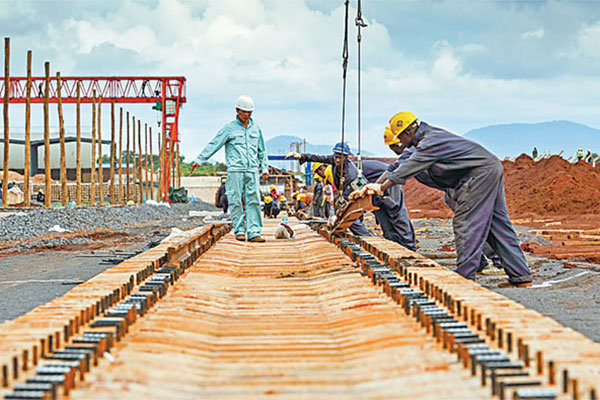 |
|
Workers lay tracks for the construction of the Mombasa-Nairobi Railway. [XIE SONGXIN/CHINA DAILY] |
An overnight train ride from Nairobi to the seaside city of Mombasa can easily turn into a nightmare. It is not unusual for passengers to wake up in the morning stuck on the outskirts of the Kenyan capital.
The train, which runs every two days, is supposed to leave Nairobi at 9 pm, but often does not depart until after midnight, and a journey that should take 15 hours can stretch to more than 20 hours.
Though slow and inefficient, the narrow-gauge railway, built by the British 110 years ago, has been a lifeline for Kenya and other East African countries, transporting passengers and goods between the two most important cities in the country.
The alternative is a highway linking the two cities, but that can be just as difficult, given that it is often heavily congested.
Only a stone's throw from the old line, work is in full swing on a new railway line, using Chinese standards and technology. That will shorten the Nairobi-Mombasa trip to four and a half hours and will bring Kenya into the 21st century.
Construction of the 472-kilometer standard-gauge railway, financed by Exim Bank of China, began in October and is expected to open in 2017. The estimated cost is $3.8 billion.
The Chinese infrastructure, engineering and construction company China Road and Bridge Corp is employing about 1,900 Chinese and more than 10,000 Kenyan engineers and skilled workers on the project. The company said it will eventually employ 2,500 Chinese engineers and 30,000 local workers.
The Kenyan government estimated that construction of the standard-gauge railway will help the country generate 1.5 percent of its GDP and eventually enable Kenya to become a gateway of East Africa after the Mombasa-Nairobi section joins other sections being built or to be built in the region.
Chen Yun, head of the project and vice-president of China Communications Construction Co Ltd, the holding company of CRBC, said: "The opening of the railway, like the wings of a bird, will prepare East Africa and even the whole of Africa for economic takeoff.
"Once the line is open it will greatly change people's work and lives generally," Chen added.
The new Mombasa-Nairobi line will play a leading role in the East Africa railway network, which will link Kenya, Rwanda, South Sudan and Uganda, and its value will become clearer when the East Africa railway network is completed and forms a large logistics circle in the region.
A more immediate effect will be a cut in transport costs.
Shipping a 6-meter container about 13,000 km from China to Mombasa costs about $1,700. Shipping it the extra 500 km or so to Nairobi can add about $1,000 to that.
The single-gauge railway is expected to reduce rail transport costs from $20 cents to 8 cents per metric ton per kilometer. It will also relieve the pressure on traffic on the highway, notable for the discarded oil containers due to accidents, and reduce the damage from the trucks to the road.
